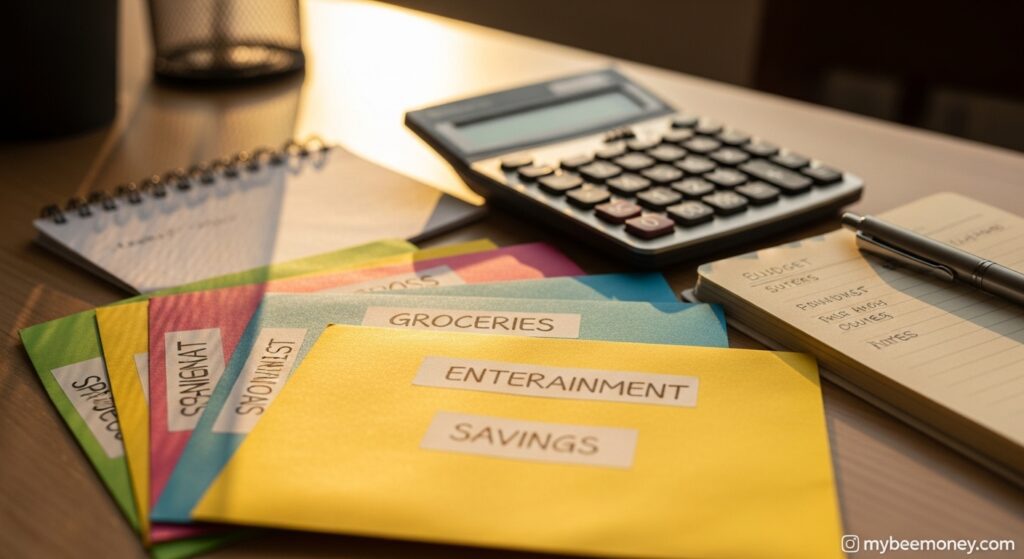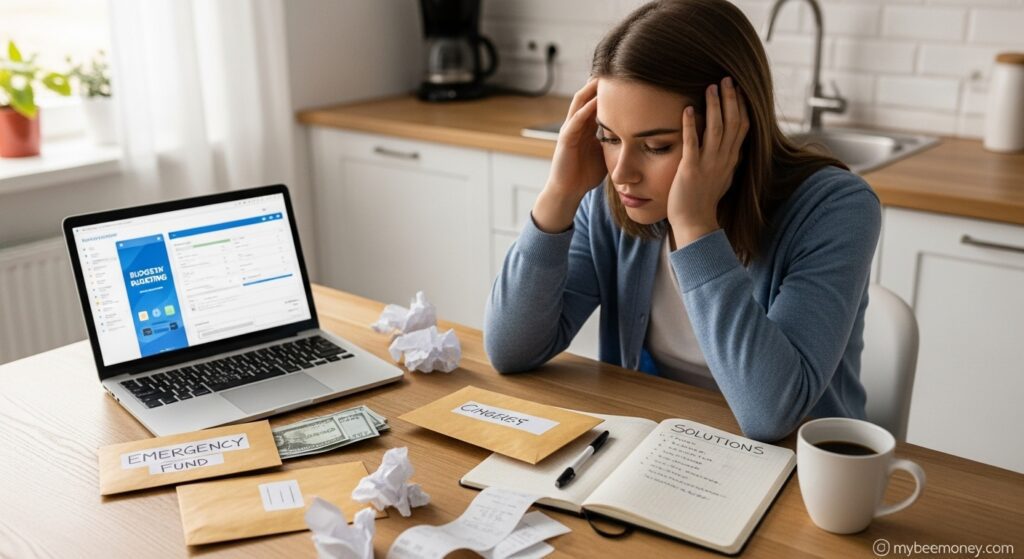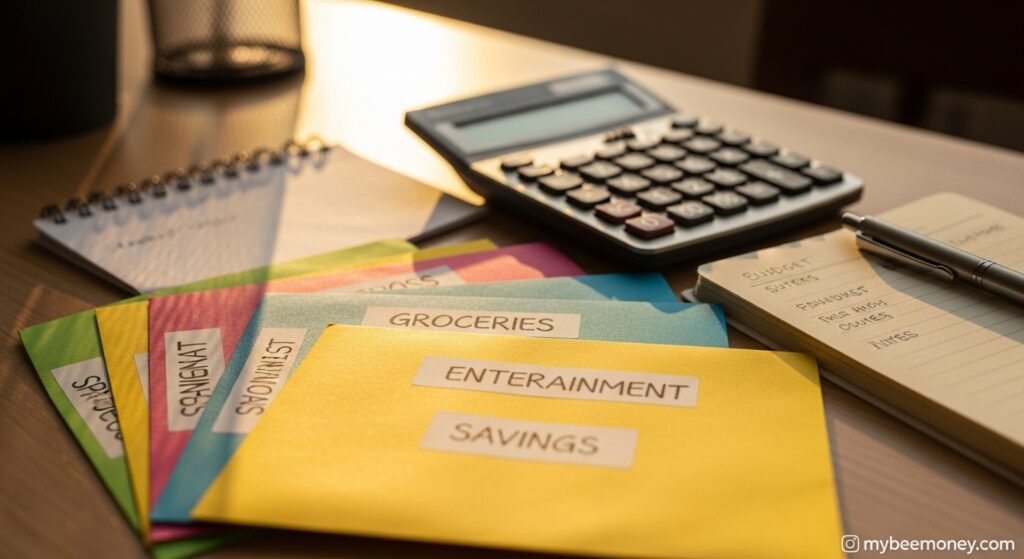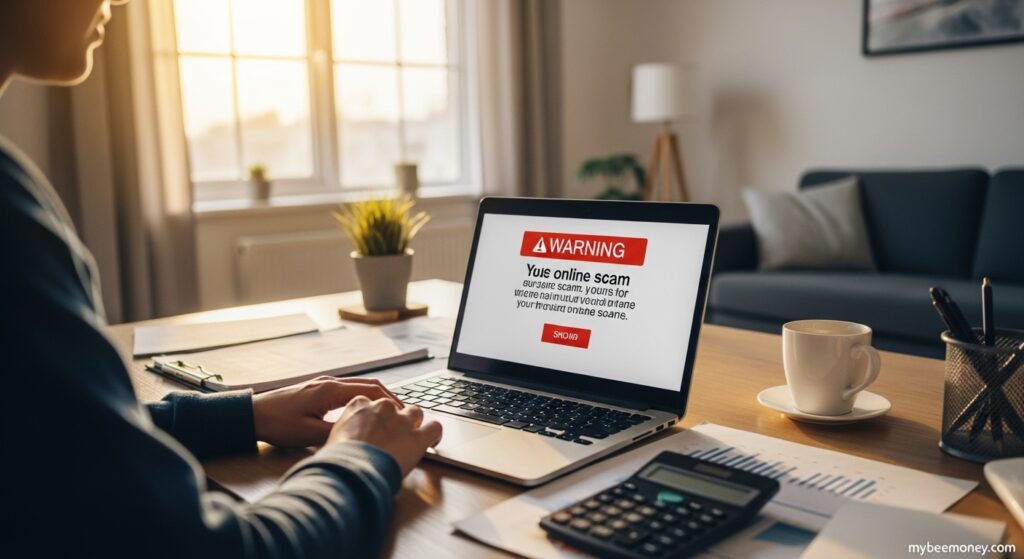
Have you ever felt like your money slips through your fingers, no matter how hard you try to save? I’ve been there, staring at an empty bank account, wondering where it all went. The frustration of not having control over my finances was overwhelming.
That’s when I discovered the power of cash envelopes, a simple yet transformative tool for budgeting. In this article, I’ll guide you through five easy steps to master your money management. Let’s dive in and take control together!
What Are Cash Envelopes and Why Use Them
I’ve often struggled with keeping my spending in check, but discovering the cash envelope system changed everything. This method involves using physical envelopes to allocate money for specific budget categories, ensuring I don’t overspend.
At its core, this approach helps me visualize my finances in a tangible way. It’s a simple yet powerful tool to manage money, and I’m excited to break it down for you.
In the sections below, I’ll explain how the system works, highlight its key benefits, and help you decide if it’s the right fit for your financial journey.
Understanding the Cash Envelope System
When I first started, I labeled envelopes for categories like groceries, entertainment, and bills. Each payday, I’d distribute cash into these envelopes based on my planned budget.
This system forces me to stick to predefined amounts. Once an envelope is empty, I can’t spend more in that category until the next cycle, which builds discipline.
Benefits of Using Cash for Budgeting
Using cash has made me more mindful of my spending habits. Unlike swiping a card, handing over physical money feels more real, curbing impulsive purchases.
Here are a few key advantages I’ve noticed:
- Control: I avoid debt by spending only what I’ve allocated.
- Clarity: I see exactly where my money goes each month.
- Simplicity: No need for complex apps or software.
Who Should Try This Budgeting Method
I believe this method suits anyone struggling with overspending or debt. If you’re like me and need a hands-on approach, cash envelopes can be a game-changer.
It’s especially helpful for beginners or those who prefer tactile systems over digital tools. If you’re ready to take charge of your finances, this could be your starting point.
Setting Up Your Cash Envelope System

As I dive into the practical side of budgeting, setting up a cash envelope system is a crucial step to gaining control over my finances. This method requires preparation and organization, but the process is straightforward and rewarding.
By breaking it down into manageable tasks, I can ensure that my system works for my unique needs. Let’s explore the essential steps to get started with this powerful budgeting tool.
Gather Supplies for Your Envelopes
To begin, I need to gather the right supplies to create my envelopes. This doesn’t have to be expensive—simple materials like paper envelopes or small pouches work perfectly.
I also grab a pen, labels, and a small notebook to track expenses. If I want durability, I might invest in reusable plastic envelopes from a local store for long-term use.
Decide on Budget Categories
Next, I determine my budget categories based on my spending habits. Common ones include groceries, transportation, and entertainment, but I tailor them to my lifestyle.
For clarity, I list them out:
- Groceries: Food and household items.
- Transport: Gas and public transit.
- Fun: Dining out or hobbies.
This personalization ensures I cover all my needs without overlap.
Allocate Your Monthly Income
Finally, I allocate my monthly income to each envelope. After calculating my total earnings, I divide the money according to my budget priorities.
For instance, if groceries are a major expense, I assign a larger portion there. I place the cash in each labeled envelope, ensuring I stick to the planned amounts for the month.
How to Fill and Label Your Envelopes
Getting the hang of filling and labeling my cash envelopes has been a game-changer in managing my finances. This step ensures that I allocate my money intentionally and track spending effortlessly.
By focusing on a few key actions, I’ve streamlined the process to avoid confusion. Let’s dive into the specifics of setting up this system effectively.
I’ve found that breaking it down into manageable tasks makes it less overwhelming. Here, I’ll share how I calculate limits, label clearly, and distribute funds.
This approach keeps my budget organized and stress-free. Let’s explore each part in detail below.
Calculate Spending Limits per Category
Determining spending limits for each category is my first priority. I review my monthly income and fixed expenses to see what’s left for variable costs.
Then, I assign realistic amounts to categories like groceries or entertainment. For instance, I might allocate $200 for food based on past spending patterns.
This step requires honesty about my habits. If I overspend on dining out, I adjust other areas to balance it out.
According to a report by the Bureau of Labor Statistics, households often underestimate discretionary spending. So, I double-check my numbers for accuracy.
Label Envelopes for Easy Tracking
Labeling my envelopes clearly prevents mix-ups and keeps me on track. I use a permanent marker to write the category name on each one.
For example, I label envelopes as “Groceries,” “Utilities,” or “Fun Money.” This visual cue helps me grab the right one without hesitation.
I also add the budgeted amount next to the category name. Seeing “Groceries – $200” reminds me of my limit every time I reach for it.
This simple habit saves time and reduces errors. It’s a small step that makes a big difference in staying organized.
Distribute Cash After Payday
After receiving my paycheck, I immediately distribute cash into each envelope. This ensures I stick to my plan before temptation creeps in.
I withdraw the total amount needed for my envelopes from the bank. Then, I sort the bills into the respective categories at home.
Here’s how I prioritize this task with a quick checklist:
- Withdraw cash within 24 hours of payday.
- Count twice to avoid mistakes.
- Store envelopes in a safe, accessible spot.
This routine sets the tone for disciplined spending. I feel in control knowing each dollar has a purpose.
Tips for Sticking to Your Cash Budget
Sticking to a cash budget can be challenging, especially when unexpected expenses or temptations arise. However, with the right strategies, I’ve found it possible to stay on track and achieve my financial goals.
In this section, I’ll share practical tips that have worked for me. These ideas focus on maintaining discipline and adapting to changes while using the cash envelope system.
By following these suggestions, I’ve gained better control over my spending. Let’s explore specific ways to make this system sustainable.
Avoid Temptation to Overspend
One of the biggest hurdles I face is resisting the urge to overspend. To combat this, I keep my envelopes at home for non-essential categories like entertainment, only taking cash when necessary.
I also set clear rules for myself, such as avoiding impulse purchases. If I’m tempted, I wait 24 hours before deciding if it’s worth dipping into another envelope.
Track Spending in Each Envelope
Keeping track of every dollar I spend is crucial for success. I jot down expenses on the back of each envelope, noting the date and amount spent.
This habit helps me see where my money goes. It also prevents overspending by giving me a real-time view of my remaining budget.
Adjust Categories as Needed
Over time, I’ve realized that my spending needs can change. For instance, if I overspend on groceries, I adjust by reallocating funds from less urgent categories like dining out.
I review my envelopes monthly to ensure they reflect my current priorities. This flexibility keeps the system practical and prevents frustration.
Here are a few quick tips for staying on track:
- Review weekly: Check your envelopes to avoid surprises.
- Stay disciplined: Stick to cash-only for budgeted categories.
- Plan ahead: Anticipate large expenses and save accordingly.
Common Challenges and How to Overcome Them

As I’ve implemented the cash envelope system, I’ve encountered several hurdles that tested my resolve. While this budgeting method is effective, it’s not without its difficulties, especially when life throws unexpected curveballs or when discipline wavers.
Understanding these challenges is the first step to mastering this system. In this section, I’ll address common issues and share practical solutions to help navigate them.
My journey has taught me that preparation and adaptability are key. Let’s explore specific obstacles and how to tackle them effectively.
Dealing with Unexpected Expenses
One major challenge is handling unexpected expenses that don’t fit into my planned categories. Whether it’s a sudden car repair or a medical bill, these costs can disrupt my budget.
To manage this, I’ve created an “emergency” envelope with a small buffer fund. I allocate a modest amount each month to ensure I’m not caught off guard.
Managing Envelope Shortages
Running out of cash in an envelope before the month ends is frustrating. It often happens with variable expenses like groceries or entertainment.
When this occurs, I reassess my spending and borrow from less urgent envelopes temporarily. I also adjust future budgets to prevent recurrence.
To avoid shortages, I track spending daily. This helps me stay within limits and make informed decisions early.
Staying Disciplined with Cash
Sticking to a cash-only system requires discipline, especially with tempting impulse buys. It’s easy to overspend when I don’t see immediate consequences.
I’ve found that setting clear goals keeps me motivated. For instance, saving for a vacation reminds me to prioritize needs over wants.
Here are some tips to maintain discipline:
- Carry only necessary cash: Leave extra money at home to avoid temptation.
- Review goals weekly: Remind yourself why you’re budgeting.
- Celebrate small wins: Acknowledge progress to stay encouraged.
These strategies have helped me stay focused and committed to my financial plan.
Success Stories with Cash Envelopes
Hearing about others’ achievements with the cash envelope system inspires me to stay committed to my own budgeting journey. These stories highlight the real impact of this method on people’s financial lives.
I’ve come across numerous accounts that show how this approach transforms spending habits. They reinforce my belief that with dedication, I can achieve similar results.
The following sections dive deeper into specific experiences and benefits. Let’s explore how this system creates lasting change for many, including myself.
Real-Life Budgeting Wins
I’ve read about individuals who turned their finances around using cash envelopes. One story mentioned a family cutting their grocery overspending by 30% in just two months.
Another person shared how they paid off $5,000 in debt by strictly following envelope allocations. These wins motivate me to keep pushing forward with my own budget.
How Cash Envelopes Build Habits
Using cash envelopes has taught me discipline in managing money. I’ve noticed how physically handling cash makes me think twice before spending impulsively.
Over time, I’ve developed a habit of planning purchases carefully. This system ingrains a mindset of intentionality, which I now apply to other areas of life.
Long-Term Financial Impact
The long-term benefits of cash envelopes are undeniable for me. Sticking to this method has helped me build an emergency fund over the past year.
I’ve also seen others achieve goals like saving for a home down payment. According to a report by a financial planning group, consistent budgeting methods like this increase savings rates by up to 20%.
Here are some key impacts I’ve observed:
- Reduced debt: Limiting spending to cash prevents overspending.
- Increased savings: Extra funds go straight to goals.
- Financial peace: Knowing where my money goes reduces stress.
Conclusion
Mastering your budget with cash envelopes is a simple yet powerful strategy. In just five easy steps, I’ve shown how to allocate funds, track spending, and regain financial control with this practical method.
Reflecting on my journey, I encourage you to start small and stay consistent. Take the first step today to transform your financial habits and achieve your goals.
For reliable financial education resources and official U.S. government information on personal finance, visit MyMoney.gov
FAQ
Can I use cash envelopes if I mostly pay bills online?
Yes, you can set aside an envelope for online bills by transferring the allocated cash to your bank account as needed. This keeps your budget intact while accommodating digital payments.
What do I do if I overspend in one category early on?
If an envelope runs out, I resist borrowing from others and instead adjust my spending by cutting back in non-essential areas. This helps maintain overall budget discipline.
How do I handle unexpected expenses with this system?
I keep a small emergency envelope with a modest amount for unforeseen costs. This prevents disrupting other categories and ensures I’m prepared for surprises.
Is it safe to carry cash envelopes everywhere?
I recommend keeping only the necessary envelopes with me and storing the rest in a secure place at home. This minimizes the risk of loss or theft.
How often should I review my cash envelope allocations?
I review my allocations monthly to adjust for changes in income or expenses. This ensures my budget remains realistic and effective over time.













